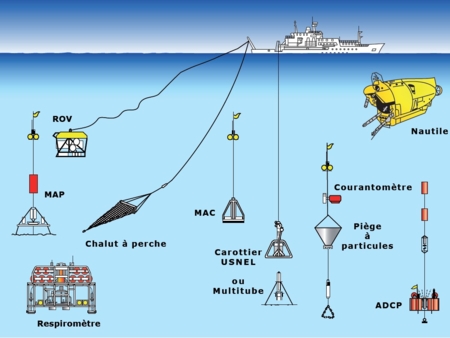Thesis defense of Marion Guéganton
Acquisition of symbiotic partners: modalities and consequences on the establishment, distribution and ecology of hydrothermal species
Please come to Marion Guéganton's defense. It will take place in IUEM, the 30th of March at 14:00 pm amphi A
Abstract
Microbial communities ensure primary energy production through chemosynthesis in deep-sea hydrothermal vents. Symbiotic associations (called holobionts) are there a commonality. This is the case of the emblematic shrimp R. exoculata and R. chacei, from vent sites of the Medio-Atlantic Ridge (MAR). Despite contrasting biological traits (morphology, demography, nutrition), each species exhibits a dense and trophic symbiosis in its cephalothoracic cavity (almost exclusively in R. exoculata, partially in R. chacei) and a double symbiosis in its digestive system. Post-settlement, a progressive trophic change has been observed in juveniles (diet based on photosynthetic sources to a mixed or chemosynthetic diet). This observation implies a progressive acquisition of a trophic symbiosis after dispersal and settlement at vents. Thus, the aim of my PhD was to study the evolution of symbiosis in juveniles of both species, in order to understand the acquisition phenomena and the recruitment dynamics of populations of the two species. The in-depth study of the symbiosis of the adult digestive system gave a more precise picture of the location of the main lineages (Hepatoplasmataceae: stomach; Candidatus Microvillispirillaceae: digestive tube) and allowed to understand their potential role for the holobiont. Thanks to microscopic and metabarcode approaches, a triple symbiosis, similar to that of adults, was identified in juvenile Rimicaris spp, and allowed to suggest various hypotheses: (1) post-settlement horizontal transmission of cephalothoracic symbionts (similar to adults), (2) post-settlement colonization of the digestive system later during recruitment (single infestation of the digestive tube via contamination by congeners; horizontal transmission or via contamination by nearby adults in the stomach), (3) a possible explanation for the collapse of R. chacei populations (less efficient development of the symbiosis). This research work has thus laid the foundations for understanding symbiosis in juveniles and the key moment of this acquisition and opens new questions.







